This Bed We Made review – Only a few minor reservations about this suspenseful Hitchcockian 1950s hotel mystery
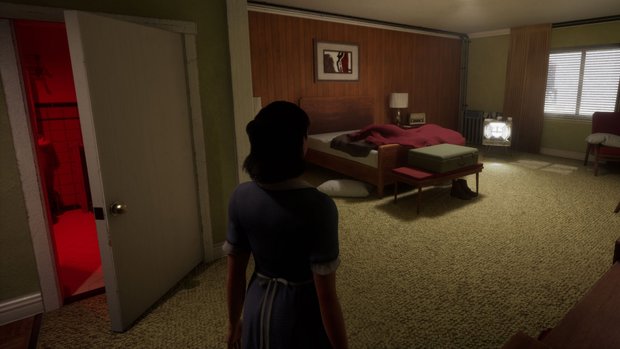
- 0 Comments
I hate cleaning. I’ll do it, but the only aspect I like about it is the end result, where you can bask in the glory of a pristine house, which might stay that way for five minutes or so if you’re lucky. (And, of course, the approval of my wife. I like that very much.) But cleaning itself, nosirree. So why, then, would I want to spend the precious free time I have to play This Bed We Made, where you take control of a maid in a hotel whose only job is to clean the rooms? Well, because in between the domestic tasks, you have the (semi-)complete freedom to snoop around! What do the guests pack in their suitcases? What secrets are written on those papers left carelessly on the desk? Is that a torn-up note in the wastebasket? There isn’t as much freedom or player choice as I’d expected, but the experience is like watching a long-lost interactive Hitchcock thriller making you more and more paranoid with each messy bedroom you encounter.
It’s Monday, February 17th, 1958 at the Clarington Hotel in Montreal. It’s a different world, when divorce and same-sex relationships are still heavily frowned upon. You’ll see flyers and pamphlets condemning them all over the place, and their presence helps establish the timeframe and context in which the story takes place and why certain things occur as they do.
You play as Sophie Roy, a 21-year-old maid who is escorted into an interrogation room at the local police station after a hard day’s work. Something has happened, obviously, and Sophie seems to be a key witness. In a black-and-white opening scene, you control Sophie from a third-person point of view. You move her around with WASD, with no key rebinding available. The camera is also limited in its movements; you only have about a 60-degree view of the police station hallway. For a while I thought the game was bugged, but when the camera moved normally in a full 360 degrees in the next scene, I realized this part was intentional, though I don’t know why exactly. There’s another scene near the end of the game where this happens again, effectively forcing you to direct Sophie along a preordained path. For the most part, however, you control the protagonist freely, moving the camera around with the mouse and clicking to manipulate hotspots.
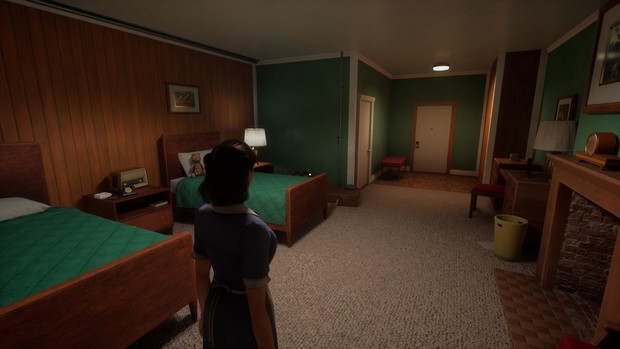
After Sophie is seated in the interrogation room, the detective asks her to tell everything that has happened since that morning. The scene flashes back to Sophie, this time in full color, wielding a vacuum cleaner in a hotel room. A jaunty French song blares over the radio, to which Sophie sings along, and from there we get handed the controls over the rest of Sophie’s work day. This Bed We Made is an exploration and investigation game where you walk around and examine everything there is to see, interacting with any objects you can. The latter is necessary gameplay: Sophie is a maid, after all, and her job is to clean the guestrooms. You’ll have to make the beds, clean the bathtub, scrub stains out of the carpet, and pick up trash and ashtrays that have tumbled to the floor. All pretty basic cleaning fare that doesn’t need much dexterity.
But it does bring some confusion. As I finished with the beds and entered the bathroom, I noticed three cleaning tags: the tub, the toilet and the mirror. The first two I could clean without a problem. When I tried to clean the mirror, though, the tag flickered red. There was a towel draped over it, but Sophie couldn’t remove it. This led me to believe I needed something, perhaps a bag to collect the towels in, even though I didn’t need a cleaning tool for the other tasks. (Sophie always whips out a cloth, and then you have to move the mouse back and forth over the stains until they are gone.) So I kept looking for a way to clean the mirror. I even left the room, thinking perhaps the cleaning cart out in the hallway might be useful. But no, walking out the door triggered a cutscene and I found myself down in the lobby for the next section of the game.
In the end, I just gave up and looked up some video walkthroughs. Turns out, nobody has been able to clean that mirror. Elsewhere there’s a nightstand drawer you could presumably open if not for some suitcases blocking it, but there’s no apparent way to move them out of the way. Why turn these things into hotspots in the first place if there’s no way to actually do the job? I lost lots of time trying to accomplish something that was never going to work, apparently. Fortunately the only other times I saw hotspots flashing red, it simply meant that I needed another item to accomplish the task.
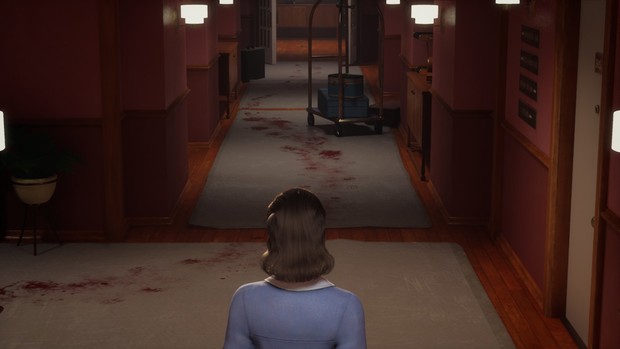
Anyway, with the cleaning out of the way, Sophie sees a letter on the desk, an open suitcase in the corner, and another piece of paper on the nightstand. So what do you do? Do you leave the room after your tasks are finished, closing the door behind you? Or do you take your time and read everything you can get your sneaky little hands on? For an adventure gamer, that’s really no choice at all.
When examining a document, you can trigger plain text for a clearer reading with a tap of the spacebar. Most of the time the actual text is quite legible to begin with, especially when the additional zoom function pops up to allow you to search the text for further clues. Not all documents feature that possibility, though, so this feature is very handy on occasion for making out less discernible handwriting.
At the start of the game there’s no real objective. There’s also no clue as to the consequences of your behavior. Will somebody find out you’ve been snooping around? Will you lose your job? Will you perhaps uncover some dark secrets? Will you be able to save someone’s life with the knowledge acquired? It’s anyone’s guess at that point. It’s even possible to leave a room without having done any of the cleaning. I was under the impression there would be free access to the entire hotel, with the choice to be professional and only do your job, or blatantly violate the guests’ privacy. However, the story usually takes firm hold of the reins, effectively limiting your choice of where to go and what to do.
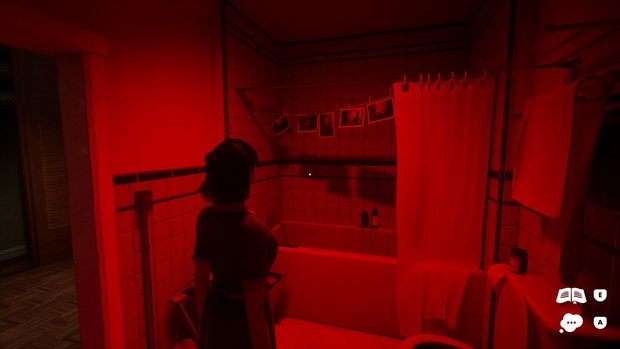
You do have some control over your actions, at least. All the evidence you uncover that might point towards a particular suspect in the crime that has occurred can be theoretically thrown in the trash so the police won’t find it – or not; it’s up to you whether or not to do so. Just remember, once you’ve examined something it’ll carry your fingerprints! These options add some replayability to make other decisions and see what the consequences will be, though unfortunately you can’t skip through cutscenes you’ve seen already. This Bed We Made allows manual saving in addition to regular automatic checkpoints, and the save files come with an informative story progression percentage. Recording your own progress is hardly necessary, however, since every autosave uses a new file.
Many conversations with NPCs offer dialogue choices; thankfully without a time limit, so you can take as long as you want to reply, even if that isn’t realistic. The hotel staff likes to gossip, but you can choose how much you want to share yourself. And when the real trouble starts, you can even choose which of two possible characters you want to confide in and ask for help. Some dialogue options feature the comedy and drama mask symbols, indicating you can pick these replies if you want to lie. Others show a little heart, meaning you can try to romance your confidant if you so desire. Some replies also have an arrow; picking these means you can go back to the top of the dialogue tree and ask the other questions as well, while options without an arrow will always progress the conversation and either end it or introduce new dialogue options.
When a red icon appears in the bottom right corner of the screen, you can trigger Sophie’s thoughts with the press of a button. These work as a kind of task manager where Sophie will remind you what she’s supposed to do next. Her journal becomes available as well, in which you’ll find entries about Sophie’s discoveries, profiles of all extra characters, and a list of all clues found. The latter is handy to review documents, making it unnecessary to return to a room to check the originals again. Which is crucial if you threw them in the trash earlier, as you wouldn’t even be able to dig them back out to read again.
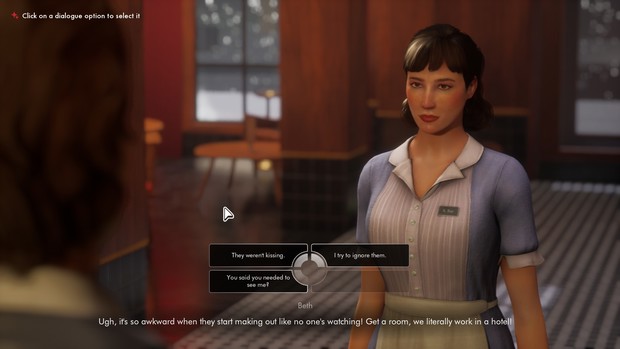
While the 3D character models are very detailed, their faces are a bit bland, with almost no range in facial expressions and lip sync that always feels a bit off. There’s a slight hint of actress Jennifer Lawrence in Sophie, but this disappears when she turns in profile. The environments are nicely detailed as well, and it definitely feels like you’re walking around in a real hotel, filled with furniture, wall decorations, and of course all the guests’ belongings scattered all over the place. The 1950s time period shines through everywhere: the artwork, the outfits, rotary phones, the absence of digital tools, but most importantly for this story, in the general public’s views on “normal” relationships and marriage. It’s an era where people still wrote letters to each other, and exchanged encoded messages as if they were little children again playing at spies, containing sensitive information about their personal lives.
Sophie is only assigned to the fifth floor, and other than that your access is limited to the ground floor with the lobby and some offices, and the basement with the staff lockers, break room and laundry room. There are other limits to player freedom as well. You can never choose where to take the elevator, and Sophie will automatically make all phone calls necessary for the narrative. Being able to hear Sophie’s thoughts and read her journal all but does away with any challenge, like finding the codes for safes and suitcases. It’s a bit of a lost opportunity, but This Bed We Made is clearly meant to be more enjoyed as a story game than a puzzle game, pretty much solving every riddle for you.
Cutscenes are accompanied by music, but during regular gameplay the hotel can be awfully silent. Thankfully Sophie has a sweet, soothing voice, and there are plenty of details for her to comment on. The other members of the hotel staff can often be heard talking to each other. You can eavesdrop on them, but it can be weird to discover the phone conversation the janitor is conducting in the lobby, for example, is playing on a constant loop. The subtitling in this instance is a bit fickle too; it’ll only appear when you’re close enough to the characters, even though you can hear their conversations from farther away. And even standing close enough doesn’t trigger them every time. At least the voice actors have all done their jobs extremely well; I always believed what they were saying, even if their faces didn’t necessarily show it.
Thankfully, the story of This Bed We Made more than makes up for all the little nitpicks. It’s pure Hitchcockian, in my opinion. Sophie hears strange noises in the hallway but can’t find the source. Soon she discovers a plot she seems to be personally involved in for some reason, without a clue as to the reason. Her cleaning duties eventually give way to some detective work. It’s not about snooping around for curiosity’s sake, it’s about finding out as much as you can to save your own hide (and perhaps others’ as well). Suddenly the weight of decisions becomes much more prevalent. Who do you talk to? What do you say? Which items do you leave and which do you throw in the trash? What’s incriminating or not? I started the game thinking I was playing the role of an innocent maid, but as the story progressed I began feeling more and more like a criminal myself, to the point that I started to wonder if Sophie herself might have something to hide that I wasn’t aware of as the player! The tension grows and you start questioning your every move even as you’re the one directing Sophie to make them.
After going through the events of the day, you return to the black-and-white scene at the police station. This time you will have to answer some questions, but be careful: depending on what you did in the hotel, they might know when you’re lying! After the interrogation, you return to the hotel one final time to take care of some loose ends and see which ending you’ll get. Before the credits roll, you’re shown some newspaper headlines and a couple of hand-painted graphic-novel-style stills showing what has become of all the important characters. As a gamer, it became obvious to me here how the different endings might work. It all depends on how you play, what you do or even don’t do.
Final Verdict
I must admit, I was hoping to be a bigger snoop in this game, so I was a bit disappointed that I couldn’t go into every room of the hotel at will and see everything there was to see. And yet while the narrative hijacked my intentions, it also raised the bar. This Bed We Made could very well have been a Hitchcock movie back in the 50s. The result is more of an interactive story than a true adventure game, pretty much devoid of typical puzzles, instead challenging you to think about your every move and what the repercussions might be. The intricate narrative encompasses the game’s global “puzzle,” and is certainly harder to figure out than which item or dialogue option to choose. It’s obvious there are several variations to the ending – concerning your own employment at the hotel, your relationship with your confidant, and which suspect is charged with murder – but even after a single playthrough, my curiosity is fully satisfied, as I found myself content with my particular ending. It’s a different, gameplay-lite take on the detective genre, but if you’re looking for a riveting mystery in which you leave no sheets rumpled, and even have a say in the final outcome, This Bed We Made is one you won’t want to turn down.
Hot take
This Bed We Made sacrifices some snooping freedom and player challenge for a more linear narrative, but there are plenty of thrilling discoveries to unpack in this compelling Hitchcockian mystery.
Pros
- Thrilling 50s era storyline worthy of a Hitchcock movie
- Snooping through other people’s dirty laundry is naughty fun
- Outstanding voice cast really sells the dramatic mystery
- Multiple endings depending on how you handle things
Cons
- Linearity sacrifices much of the freedom to explore
- Some hotspots are confusingly non-interactive
- Cutscenes can’t be skipped during replays
Johnny played This Bed We Made on PC using a review code provided by the game's publisher.

- Advertisement
- Help support AGH by advertising with us











0 Comments
Want to join the discussion? Leave a comment as guest, sign in or register.
Leave a comment